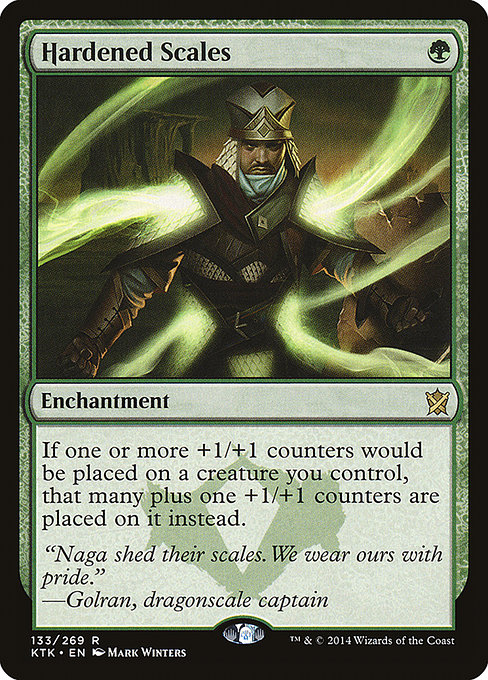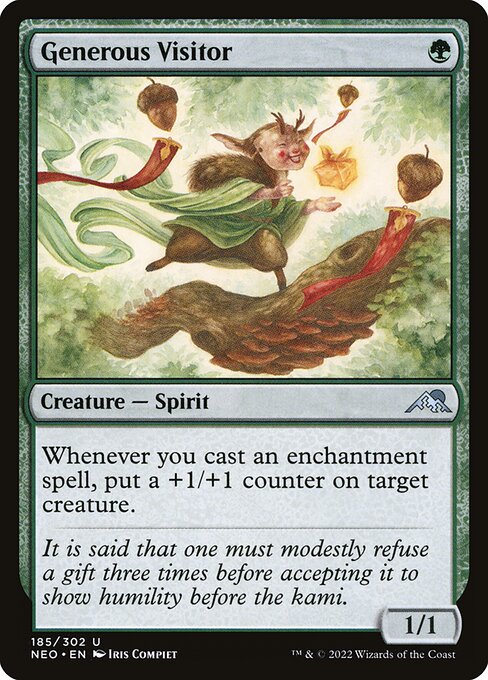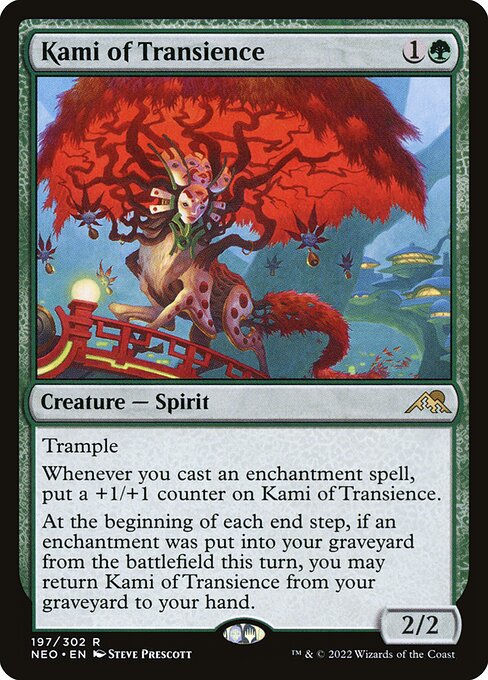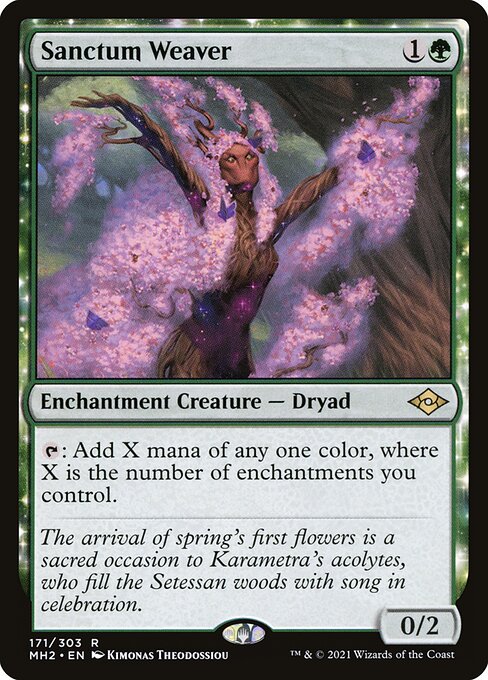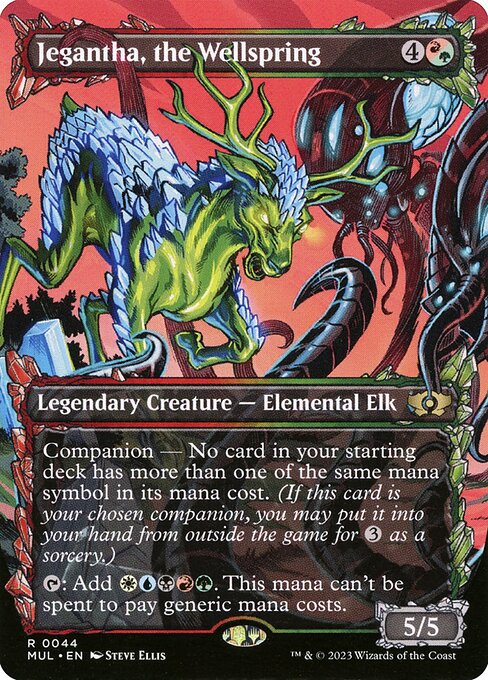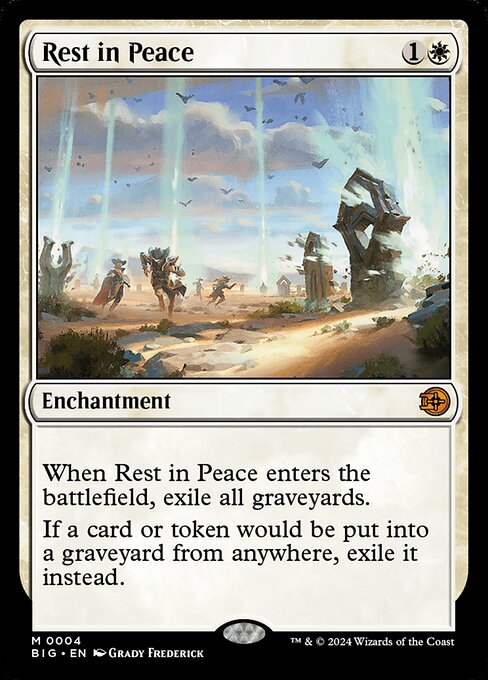Table of Contents
Hey everyone! Today I’m going to be covering my Naya Hardened Scales Enchantress deck in Historic which I recently used to hit rank #1 Mythic with on the Arena ladder.
This is a deck that combines enchantment and +1/+1 counter synergies and is capable of some fast aggressive starts, has good tools to produce a lot of card advantage in the mid-late game, and also has the potential to One Turn Kill (OTK) the opponent out of nowhere off the back of Hardened Scales alongside cards like Showdown of the Skalds and Kami of Transience!
I’ve put up a video on my YouTube channel with with 5 matches of game play if you’re interested in seeing the deck in action.

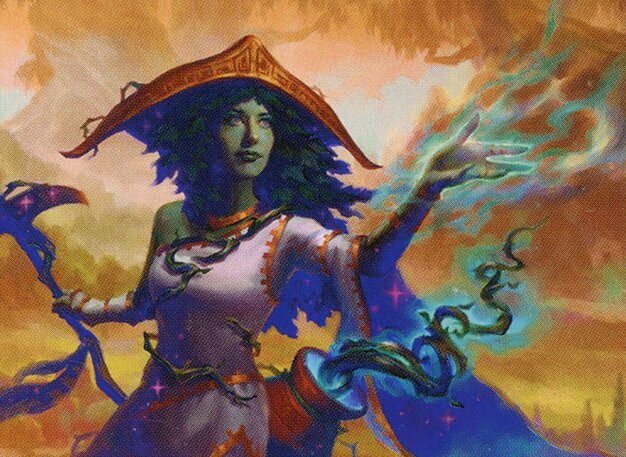

Companion
Creatures (24)
Lands (24)
60 Cards
$326.08
Sideboard
15 Cards
$10.45
Main Deck:
+1/+1 Counter Synergies:
Hardened Scales: This is one of the central cards in the deck and helps capitalize on all of the ways we have of putting +1/+1 counters on our creatures. This is an incredibly powerful effect to have for 1 mana, and the fact it’s an enchantment itself also plays very well with our enchantment synergies.
Hardened Scales enables very aggressive starts as we can grow our creatures very quickly, it allows us to build a big board to be able to stabilize against other creature decks, and it also enables some crazy combo-esque turns where we can potentially put 20 or more +1/+1 counters on our creatures in a single turn!
Generous Visitor: We have a load of enchantments in the deck so we can start putting a bunch of +1/+1 counters on our creatures as early as turn 2; this is great at enabling aggressive starts, as well as growing our creatures to be able to block effectively against aggressive decks.
Being able to spread the +1/+1 counters around amongst your creatures is nice since it means our individual creatures aren’t as vulnerable to single-target removal, and is also good against oppossing chump blockers since we can make our whole board large. This is very efficiently costed for what it’s doing, works nicely with Hardened Scales, and often feels like a must-kill threat since it can put so much power onto the board.
Kami of Transience: Similar to Generous Visitor, this is a card that we can grow very quickly, but the fact this has Trample means it works very effectively as a way to close the game out.
This deck is capable of some crazy combo-esque turns, usually enabled by Hardened Scales alongside chapter 2 or 3 of Showdown of the Skalds, or Sanctum Weaver alongside one of our enchantress effects, and Kami of Transience is the best way to close the game out on those turns. You can often turn Kami of Transience into a 20/20 or larger out of nowhere during these turns and the Trample ensures that you can kill the opponent even if they have multiple blockers in play.
Similar to Generous Visitor, this is also a must-kill threat against a lot of decks since it will grow out of control if it’s not dealt with, but it also has inherent protection from removal since it’s recursive. We have 12 enchantment creatures in the deck, 8 of which are must-kill threats in most situations, so if the opponent does kill our Sythis, Harvest's Hand or Sanctum Weaver, we then get Kami of Transience back from our graveyard. Additionally, Showdown of the Skalds is a saga that sacrifices itself on the third chapter which will also bring back the Kami of Transience, so it’s a difficult card for the opponent to deal with permanently if they don’t have an exile effect.
Setessan Champion: This is an enchantress effect that also plays really well with Hardened Scales. Most enchantress decks in Historic usually like to run Enchantress's Presence as their 3 mana enchantress effect, but this particular build is much more aggressive and is more interested in committing to the board and applying pressure, and Enchantress's Presence just felt too slow when I tested it. Setessan Champion on the other hand still provides the enchantress effect, but is also a creature that can grow very fast, especially in conjunction with Hardened Scales.
Usually, it’s better to have the enchantress effect on cast rather than enter the battlefield (since you still get to draw if the enchantment is countered or the enchantress is killed in response), but it’s actually an advantage when played with Hardened Scales since the Setessan Champion won’t trigger until the Hardened Scales is in play which will immediately put an extra +1/+1 counter on it.
Additionally, Setessan Champion is also fairly resilient to the most commonly played removal at the moment, especially if it’s played on turn 3. 3 toughness means it can’t be killed by Unholy Heat without delirium and 3 it can’t be killed by Fatal Push without revolt, both of which are difficult for a lot of decks to achieve on turn 3.
Alongside Sythis, Harvest's Hand and Showdown of the Skalds, the continuous card advantage that Setessan Champion provides gives the deck access to a really strong mid-late game where you tend to pull so far ahead on card advantage if the opponent doesn’t have a fast answer.
Showdown of the Skalds: This is one of the most important cards in the deck, both as a way to produce a lot of card advantage and also as a way to grow your creatures and capitalize on Hardened Scales.
Getting 4 cards off the first chapter is a big burst of card advantage (as opposed to something like Enchantress's Presence which takes a lot longer to get going) and since we have a pretty low curve, we’re often able to cast all of the cards we hit off it.
The second and third chapter are also really important as they allow us to put a crazy amount of +1/+1 counters on our creatures if we have it alongside Hardened Scales or Sanctum Weaver with an enchantress effect, and often allows us to oneshot the opponent out of nowhere, especially with Kami of Transience.
The Other Cards:
Sythis, Harvest's Hand: This is the other enchantress effect in the deck alongside Setessan Champion and is so good on rate for 2 mana! Having this survive and start generating card advantage, especially alongside Sanctum Weaver, will run away with the game so it forces the opponent to have removal.
The enchantress effect is also on cast rather than enter the battlefield. This means you can wait to cast it and another enchantment in the same turn and you’re guaranteed to get at least one draw from it. The fact it also gains a life each time you cast an enchantment is huge since it helps to put games out of reach against decks like Sacrifice, Phoenix, and Burn where they can punish you for stabilising at a low life total. Additionally, it’s an enchantment itself so triggers all of our other enchantment synergies.
Sanctum Weaver: This card is another one of the most important cards in the deck. Since we have so many ways to produce card advantage, the main chokepoint in the deck is mana, and Sanctum Weaver unlocks a huge amount of mana and enables some insanely explosive starts. It’s an enchantment itself which enables all of your other enchantment synergies, and can be tapping for 6/7 mana on turn 4/5 which is absolutely insane for a 2 mana creature! Having Sanctum Weaver in play alongside your cards that produce advantage will almost always ensure that you’ll outgrind the opponent while also turning the corner and making all of your creatures huge with the +1/+1 counter synergies at the same time.
This is one of the biggest appeals to this deck to me – the real strength of the enchantress archetype in Historic is the quality of card advantage and mana production from Sanctum Weaver. The other main deck utilizing this engine is the Nine Lives + Solemnity lock deck and that often takes a long time to turn the corner and close out the game which can give the opponent time to find an answer and break through the lock (the lock is also very vulnerable to certain sideboard cards which is why I’m not a big fan of that deck in Best of 3).
This deck on the other hand can turn the corner and kill the opponent very fast due to the ability to pile stats on the board very quickly while also still taking great advantage of the enchantress engines that make the archetype so appealing.
Kami of Bamboo Groves: Since mana is the biggest chokepoint in the deck, I wanted to run another mana accelerant alongside Sanctum Weaver, and even though this is nowhere near as good as Sanctum Weaver, it’s a good alternative that gets you ahead on mana and helps fill the 1-mana slot nicely.
Being able to ramp to 3 mana on turn 2 is really nice at allowing us to start taking advantage of our card advantage engines and lets us grow our creatures faster. Even though this sort of effect becomes less valuable later in the game, it’s still useful since it’s an enchantment itself so we can essentially cycle it for 1 mana if we have a Setessan Champion or Sythis, Harvest's Hand in play while also triggering cards like Generous Visitor and Kami of Transience.
The channel ability is also nice upside – you’re never normally thrilled to spend your turn 3 or 4 just putting two forests into your hand, but if you’re missing land drops, it’s a great option to have. It even has ended up saving me in a lot of games since missing land drops in the first few turns can be really punishing in this deck.
Baffling End: Even though our proactive game plan is very strong, I felt like I wanted to run some interaction to deal with important threats like Kor Spiritdancer, Dreadhorde Arcanist, Ravenous Squirrel, etc. and Baffling End definitely feels like the best option.
It’s an enchantment so it triggers all of our enchantment synergies, it exiles which dodges certain forms of protection like Selfless Savior, and they also don’t get the creature back if Baffling End is destroyed.
Jegantha, the Wellspring: This is essentially free to run as a companion, but it does have some very nice applications. A lot of our engine cards like Sythis, Harvest's Hand and Setessan Champion are creatures which obviously make them vulnerable to decks packing a lot of creature removal, however most decks running a lot of cheap creature removal aren’t as easily able to deal with bigger creatures. Having Jegantha, the Wellspring as a fallback in those situations if we flood out works nicely as a way to stabilise (against a deck like Rakdos Midrange for example).
We can also produce a lot of mana with Sanctum Weaver, so if we have mana spare from that, we can use it to put Jegantha, the Wellspring into our hand or sometimes also cast it if we have multiple Sanctum Weavers in play.
Additionally, it can tap for mana which can be very useful if we’re just short on mana for the plays we want to make – if we had Showdown of the Skalds and another green card, we can tap Jegantha, the Wellspring to produce 3 mana to allow us to cast slightly more spells in a turn and helps unlock more mana.
Mana Base:
We do want to be hitting our fourth land drop on curve as often as possible to be able to cast Kami of Bamboo Groves. WIth this in mind, 24 lands alongside Sythis, Harvest's Hand and Setessan Champion as ways to potentially draw in the early game feels like a good amount.
On the flip side, running too many lands will frequently result in flooding out with the amount of draw effects we have, and hitting multiple lands of Showdown of the Skalds always feels bad so I don’t think you want to go any higher than 24.
Thankfully Red is only really a splash in the deck for Showdown of the Skalds and some sideboard cards so there’s not as much pressure on the mana base which allows us to run a basic Forest (as a concession to Field of Ruin) and Boseiju, Who Endures alongside a bunch of dual lands. Curving out in this deck is very important so I don’t think you want to be running any tapped lands.
Sideboard:

4 Rest in Peace: This is very important against graveyard decks like Izzet Phoenix, Greasefang, Okiba Boss, Dreadhorde Arcanist, Cat/Oven decks etc. Typically this isn’t a card you would want to be running 4 copies of since there’s pretty big diminishing returns on drawing multiples, but we can still get value of additional copies in this deck since it’s an enchantment and will trigger cards like Sythis, Harvest's Hand and Setessan Champion.
I felt like 4 copies of Rest in Peace was necessary because it’s by far the most important card against the Izzet Phoenix deck – that matchup becomes significantly easier with a Rest in Peace in play so I wanted to maximize my chances of drawing it.
3 Seal Away & 2 Arni Slays the Troll: Seal Away is additional enchantment removal that is able to deal with bigger creatures. The obvious weakness of Baffling End is it can’t deal with creatures that cost more than 3 mana which means the deck has a hard time dealing with creatures like Crackling Drake, Korvold, Fae-Cursed King, etc so Seal Away provides a nice answer to those that’s also able to deal with Arclight Phoenix and other haste creatures without taking damage.
It does have it’s drawbacks though since it doesn’t deal with creatures with vigilance or creatures that don’t attack which is why I like running a split with Arni Slays the Troll. This is another card that allows us to deal with more expensive creatures while also providing nice additional value. Since this deck is very good at growing it’s creatures, a fight effect is a fairly effective way to deal with bigger creatures, but it is also vulnerable to interaction and does require a bigger creature in the first place which is why I didn’t want to run more than 2 copies.
The second chapter putting 2 +1/+1 counters on a creature synergizes very well with the counters theme in the deck and also provides some ramp, unlocking more mana and potentially allowing us to cast something like Showdown of the Skalds on turn 3 for example. The life gain ability in the third chapter is also very important against decks with good reach in the late game.
3 Shapers' Sanctuary: This is a very important tool against decks running a lot of interaction like control and Rakdos Midrange. We have a lot of creatures that are essentially must-kill threats like Kami of Transience, Sythis, Harvest's Hand, Sanctum Weaver, Setessan Champion etc. that will run away with the game if they’re not dealt with so if we have a Shaper’s Sanctuary in play, the opponent doesn’t really have an option but 2-for-1 themselves by killing our creatures.
This allows us to grind through removal in the early game and not get run down by the opponent’s interaction. It’s also a cheap enchantment itself which triggers all of our enchantment synergies.
2 Cindervines: This is here as an enchantment that we can use to kill opposing artifacts and enchantments (against decks like sacrifice, affinity, control etc) while also dealing chip damage against slower decks.
Best of 1:
The only change I would consider for best of 1 is to potentially run some number of Rest in Peace in the main deck as a way to beat the fast graveyard-based combo decks like Greasefang, Okiba Boss, Reanimator and Dragonstorm in place of a couple of Kami of Bamboo Groves.
Typically you wouldn’t mind running some Rest in Peace in the main deck of a deck like this since it still triggers your enchantment synergies even in matchups where you don’t need the graveyard hate, but in this particular build it also shuts off the recursion on Kami of Transience which is a pretty big downside and often incentivizes you to not cast Rest in Peace in the first place. For that reason, I would leave the main deck as it is, but you can definitely considering running Rest in Peace if you wanted to improve your matchup against graveyard-based combo decks.
Matchups and Sideboard Guide:

Izzet Phoenix:
| In | Out |
|---|---|
| +4 Rest in Peace | -1 Baffling End |
| +3 Seal Away | -4 Kami of Bamboo Groves |
| -2 Showdown of the Skalds |
Rest in Peace is by far the most important card in this matchup as it shuts off both Arclight Phoenix (which this deck struggles to beat multiples of) and delirium, so it’s generally a good idea to mulligan if you don’t have a strong hand or a Rest in Peace.
Their other individual creatures are generally slower and fairly easy to deal with using Baffling End whereas this deck struggles to beat multiple Arclight Phoenix from the graveyard which is why Rest in Peace is so important.
Seal Away is nice here as a way to deal with Arclight Phoenix before it can deal damage as well as being able to take out bigger creatures like Crackling Drake.
Azorius Control:
| In | Out |
|---|---|
| +3 Shapers' Sanctuary | -4 Baffling End |
| +2 Cindervines | -1 Kami of Bamboo Groves |
This matchup is all about trying to race and apply pressure so don’t keep slow hands. Shapers' Sanctuary is great protection from their interaction in the early game, but it’s important that you don’t play slowly since cards like Farewell can be a blowout if you give them too much time.
Having said that, if you already have a lot of power on the boar, and you also have resources in hand (which isn’t uncommon if you get to resolve a Setessan Champion, Sythis, Harvest's Hand, or Showdown of the Skalds), then it’s usually worth holding onto them in order to recover from a sweeper.
In genera,l you want to try and play your engine pieces when the opponent’s shields are down, especially Showdown of the Skalds, so try and bait out the opponents counterspells and interaction on your other spells first if you can.
Auras:
| In | Out |
|---|---|
| +3 Seal Away | -2 Kami of Bamboo Groves |
| -1 Showdown of the Skalds |
This can be a tough matchup since if they have a fast hand, it will usually come down to if you have more removal than they have creatures. If you can run them out of creatures their deck basically doesn’t do anything, so you should mulligan fairly aggressively to Baffling End or Seal Away if you don’t have a strong hand.
You can often beat their slower starts without interaction since your card advantage engines allow you to dig for removal fairly consistently, but their fast starts with either Kor Spiritdancer or Light-Paws, Emperor's Voice on turn 2 usually demand an immediate answer or they tend to outrace you.
In general you want to prioritize using Seal Away first if you can since it won’t be able to exile their creature if they give it vigilance with Sentinel's Eyes. Also, always be wary of both Spell Pierce and Slip Out the Back when using your interaction, especially if the opponent is consistently leaving open blue mana.
Rakdos Midrange:
| In | Out |
|---|---|
| +3 Shapers' Sanctuary | -3 Kami of Bamboo Groves |
This sideboard plan is for regular Rakdos Midrange that isn’t utilising the graveyard so if the opponent is playing cards like Dreadhorde Arcanist and Kroxa, Titan of Death's Hunger, you’ll also want to bring in Rest in Peace.
This matchup is pretty good overall because you have so many ways to refuel which they struggle to deal with – Setessan Champion, Sythis, Harvest's Hand, and Showdown of the Skalds are the most important cards to that end. Shapers' Sanctuary is really good in this matchup since almost all of their interaction will be single-target and you have a lot of must-kill threats.
You should get Setessan Champion and Showdown of the Skalds into play as soon as possible to dodge discard spells. Setessan Champion is difficult for them to kill on turn 3 because they likely can’t enable delirium for Unholy Heat or revolt for Fatal Push immediately, but Sythis, Harvest's Hand is sometimes worth waiting to play so it’s not immediately killed by a removal spell.
Affinity:
| In | Out |
|---|---|
| +2 Cindervines | -2 Kami of Bamboo Groves |
This is another fairly good matchup since you tend to outscale what they’re doing and they don’t have great ways to interact with what you’re doing outside of Metallic Rebuke and Glass Casket.
They can’t really punish you for overcommitting to the board, so you’ll want to develop as fast as possible and get as much power into play as you can. Their best avenue to win is by getting both Nettlecyst and Shadowspear on one creature, but we can often outscale that with our +1/+1 counters.
Cindervines is great here at giving us an answer to any of their problematic artifacts while also dealing chip damage – generally you’ll want to save it to kill Nettlecyst, Karn, Scion of Urza tokens, or a Portable Hole / Glass Casket that’s exiled an important card of ours.
Selesnya Enchantress:
| In | Out |
|---|---|
| +2 Cindervines | -2 Kami of Bamboo Groves |
This matchup is all about racing since we don’t have a good way of stopping the Nine Lives + Solemnity lock outside of Cindervines and we generally go tall rather than wide with out creatures which makes it tough to attack through Nine Lives. For this reason, it’s important that you don’t keep slow hands and you try and get in for as much damage as quickly as you can.
You should kill both Sythis, Harvest's Hand and Sanctum Weaver on sight with Baffling End as that will slow them down a lot, and you should always save Cindervines to kill either Solemnity or Sterling Grove.
Selesnya Heliod Combo:
| In | Out |
|---|---|
| +2 Arni Slays the Troll | -4 Kami of Bamboo Groves |
| +2 Seal Away |
This matchup will come down to if you can kill them before they combo. For this reason, you should mulligan any hand that doesn’t have a fast start or some removal. In general, you should prioritize taking out their life gain enablers first since that shuts off both the combo side of their deck and their Voice of the Blessed and Trelasarra, Moon Dancer from growing.
Their deck doesn’t recover from removal very well unless they get lucky top decks, so digging for more removal when you’re planning out your turns should be a priority – just going aggressive instead won’t always work since they can gain a lot of life.
5C Niv:
| In | Out |
|---|---|
| +3 Shapers' Sanctuary | -2 Baffling End |
| -1 Kami of Bamboo Groves |
This matchup is similar to the UW Control matchup except Niv tends to run more creature removal and fewer counterspells, which makes Shapers' Sanctuary even more effective. If you don’t have Shapers' Sanctuary in your opening hand, it’s generally a good idea to mulligan slow hands especially when going second, as they have a very strong lategame.
One of the other key differences between UW control and Niv is that Niv usually runs Deafening Clarion as its sweeper rather than a hard sweeper. Clarion is much easier to play around in this deck because of the +1/+1 counters, so try and grow your creatures to 4 or more toughness as a priority – this will also help play around Lightning Helix. Finally, I like keeping in 2 copies of Baffling End here in order to deal with Territorial Kavu.
Embercleave Aggro (Mono R/Gruul):
This matchup is all about stabilizing, either by building up big blockers or using removal, so make sure your opening hand either has ways to grow you creatures quickly so they can block or some interaction.
Your creatures can often outscale theirs very quickly but Embercleave is still a big threat so try not to make any risky attacks early on as letting damage through that you could have prevented can be very costly.
Humans:
This matchup can be tough since they go wider faster than most other aggro decks which makes them less vulnerable to our single-target removal, and they have taxing effects like Thalia, Guardian of Thraben which can slow us down.
In general, you want to prioritize getting Sanctum Weaver into play as soon as possible since that unlocks a lot of mana and allows us to commit to the board faster to stabilize and enables us to play around their taxing effects like Thalia, Guardian of Thraben and Esper Sentinel.
Additionally, getting Generous Visitor or Kami of Transience down early and growing it is also good at slowing them down in the early game, especially alongside Hardened Scales.
Tips & Tricks:

- Do be aware that you’re forced to play pathways on their front side when putting them into play off Kami of Bamboo Groves so if you had an opening hand with Stomping Ground and Branchloft Pathway as your only lands for example, it’s usually best to hold onto Kami of Bamboo Groves to either channel or trigger one of your enchantment payoffs later or you’ll be cutting yourself off white mana if you put the pathway into play off it on turn 1.
- Always calculate whether you can kill the same turn with Hardened Scales before starting to apply +1/+1 counters with Generous Visitor and Showdown of the Skalds to creatures with summoning sickness.
- Similarly, if you have Sanctum Weaver in play, it’s a good idea to plan your turn out before you start doing anything. This includes thinking about cards you could potentially draw off your enchantress effects or Showdown of the Skalds. You can miss out on mana if you tap Sanctum Weaver before you play your enchantments, but you can also lock yourself out of playing certain cards if you tap all of your lands before tapping Sanctum Weaver since it can only tap for mana of one color.
- You don’t need a creature in play in order to get the red mana off the second chapter of Arni Slays the Troll which is important if you wanted to use it to ramp. Additionally, you don’t get the red mana if the opponent kills the creature you’re trying to put 2 +1/+1 counters on, so if you really need the red mana, it can be worth choosing not to put the +1/+1 counters on to play around removal.
Conclusion:
This deck has been so much fun to play since it has elements of aggro, midrange and combo all in one, and the explosive starts and Hardened Scales turns are really difficult for most decks to deal with. Thanks a lot for reading!
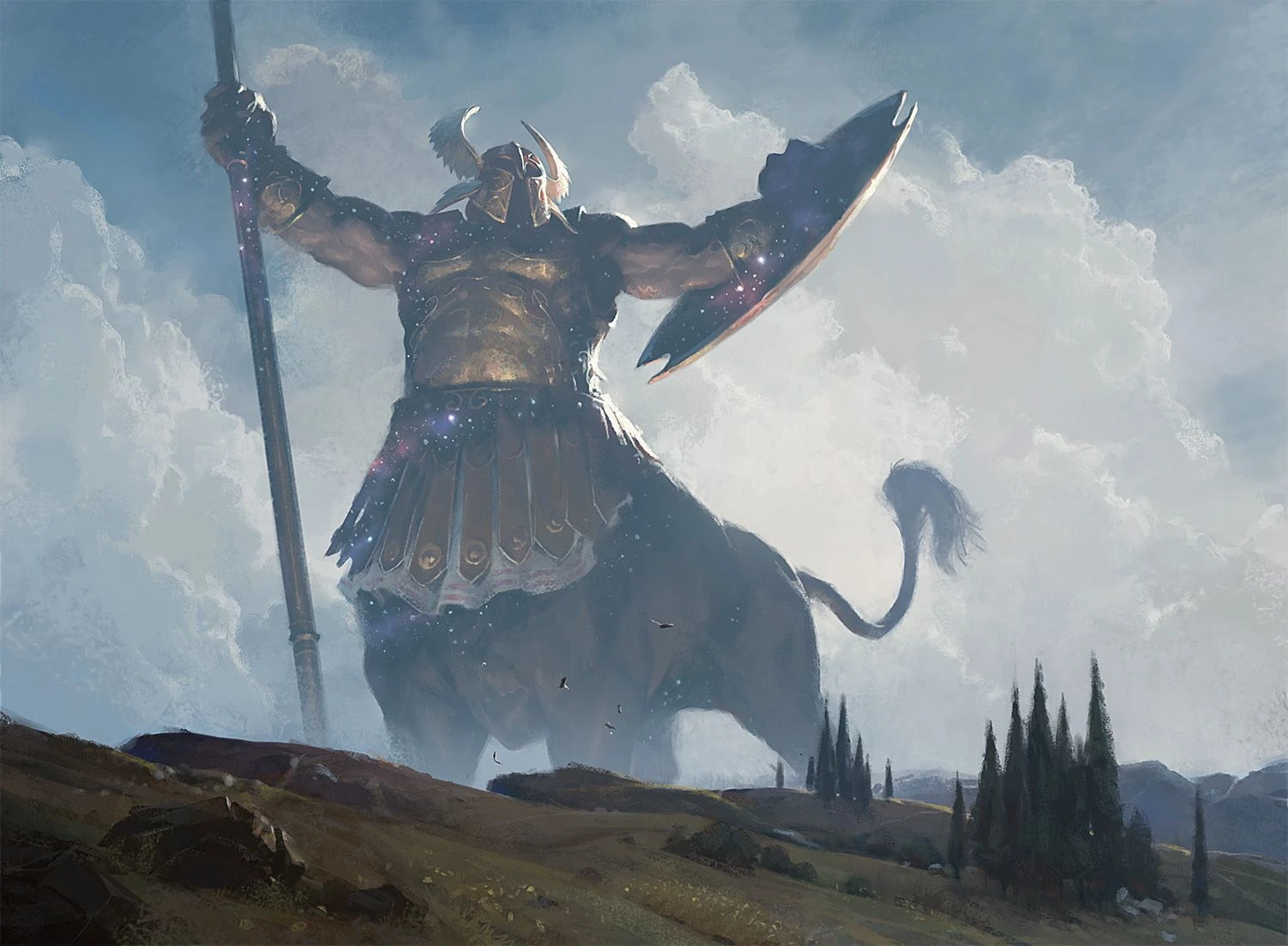
Premium
Enjoy our content? Wish to support our work? Join our Premium community, get access to exclusive content, remove all advertisements, and more!
- No ads: Browse the entire website ad-free, both display and video.
- Exclusive Content: Instant access to all exclusive articles only for Premium members, at your fingertips.
- Support: All your contributions get directly reinvested into the website to increase your viewing experience!
- Discord: Join our Discord server, claim your Premium role and gain access to exclusive channels where you can learn in real time!
- Special offer: For a limited time, use coupon code L95WR9JOWV to get 50% off the Annual plan!


























